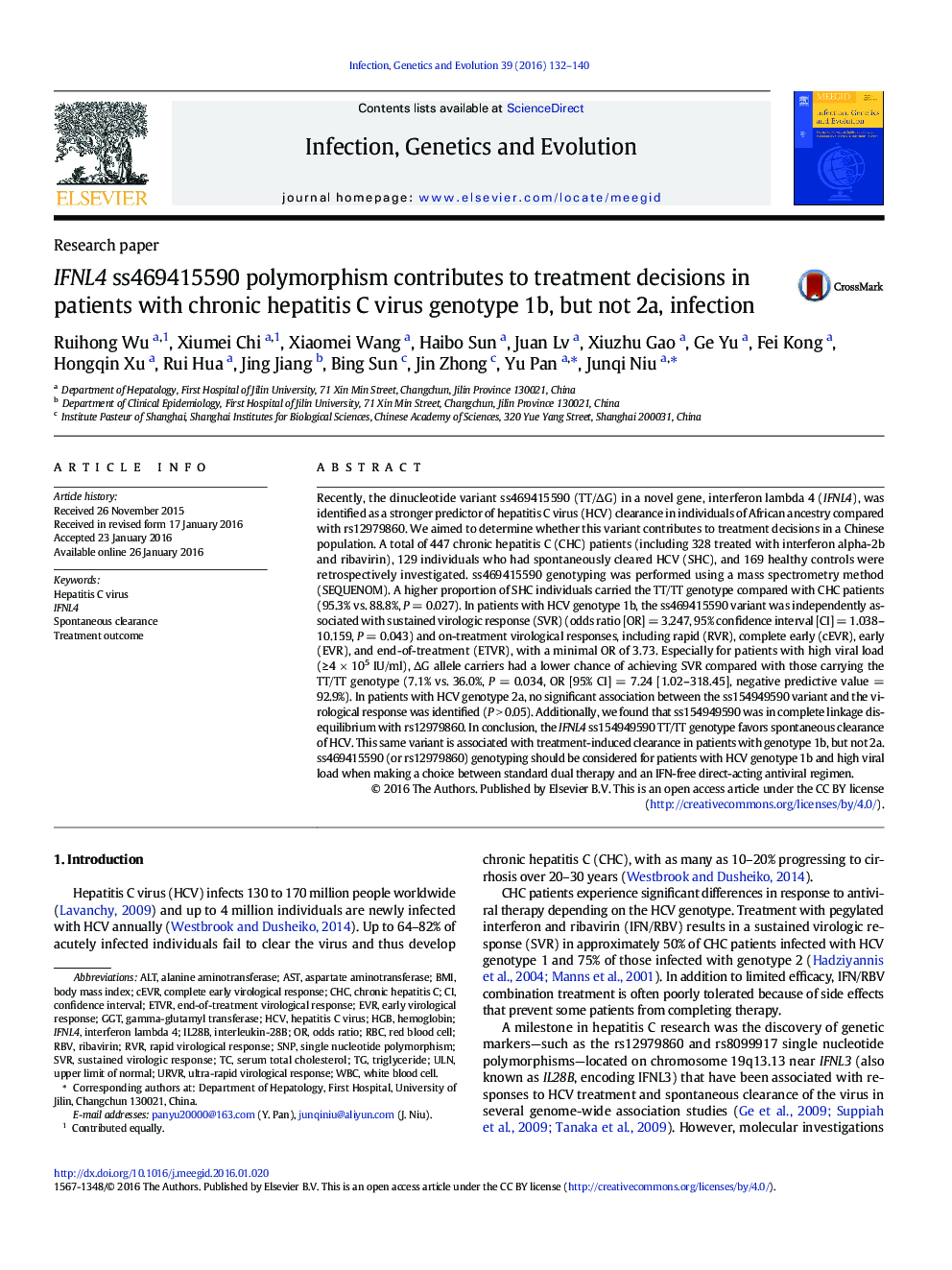| Article ID | Journal | Published Year | Pages | File Type |
|---|---|---|---|---|
| 5908726 | Infection, Genetics and Evolution | 2016 | 9 Pages |
Abstract
Recently, the dinucleotide variant ss469415590 (TT/ÎG) in a novel gene, interferon lambda 4 (IFNL4), was identified as a stronger predictor of hepatitis C virus (HCV) clearance in individuals of African ancestry compared with rs12979860. We aimed to determine whether this variant contributes to treatment decisions in a Chinese population. A total of 447 chronic hepatitis C (CHC) patients (including 328 treated with interferon alpha-2b and ribavirin), 129 individuals who had spontaneously cleared HCV (SHC), and 169 healthy controls were retrospectively investigated. ss469415590 genotyping was performed using a mass spectrometry method (SEQUENOM). A higher proportion of SHC individuals carried the TT/TT genotype compared with CHC patients (95.3% vs. 88.8%, P = 0.027). In patients with HCV genotype 1b, the ss469415590 variant was independently associated with sustained virologic response (SVR) (odds ratio [OR] = 3.247, 95% confidence interval [CI] = 1.038-10.159, P = 0.043) and on-treatment virological responses, including rapid (RVR), complete early (cEVR), early (EVR), and end-of-treatment (ETVR), with a minimal OR of 3.73. Especially for patients with high viral load (â¥Â 4 Ã 105 IU/ml), ÎG allele carriers had a lower chance of achieving SVR compared with those carrying the TT/TT genotype (7.1% vs. 36.0%, P = 0.034, OR [95% CI] = 7.24 [1.02-318.45], negative predictive value = 92.9%). In patients with HCV genotype 2a, no significant association between the ss154949590 variant and the virological response was identified (P > 0.05). Additionally, we found that ss154949590 was in complete linkage disequilibrium with rs12979860. In conclusion, the IFNL4 ss154949590 TT/TT genotype favors spontaneous clearance of HCV. This same variant is associated with treatment-induced clearance in patients with genotype 1b, but not 2a. ss469415590 (or rs12979860) genotyping should be considered for patients with HCV genotype 1b and high viral load when making a choice between standard dual therapy and an IFN-free direct-acting antiviral regimen.
Keywords
IFNL4CHCRBVinterleukin-28BULNALTRBCWBCIL28BEVRSVRRVRGGTcEVRETVRASTAspartate aminotransferaseAlanine aminotransferasetriglycerideUpper limit of normalRibavirinbody mass indexBMIconfidence intervalTreatment outcomeodds ratioHemoglobinHgbchronic hepatitis CHepatitis C virusHCVRapid virological responseearly virological responseSustained virologic responsecomplete early virological responseSpontaneous clearanceSingle nucleotide polymorphismSNPSerum total cholesterolGamma-glutamyl transferasewhite blood cellred blood cell
Related Topics
Life Sciences
Agricultural and Biological Sciences
Ecology, Evolution, Behavior and Systematics
Authors
Ruihong Wu, Xiumei Chi, Xiaomei Wang, Haibo Sun, Juan Lv, Xiuzhu Gao, Ge Yu, Fei Kong, Hongqin Xu, Rui Hua, Jing Jiang, Bing Sun, Jin Zhong, Yu Pan, Junqi Niu,
